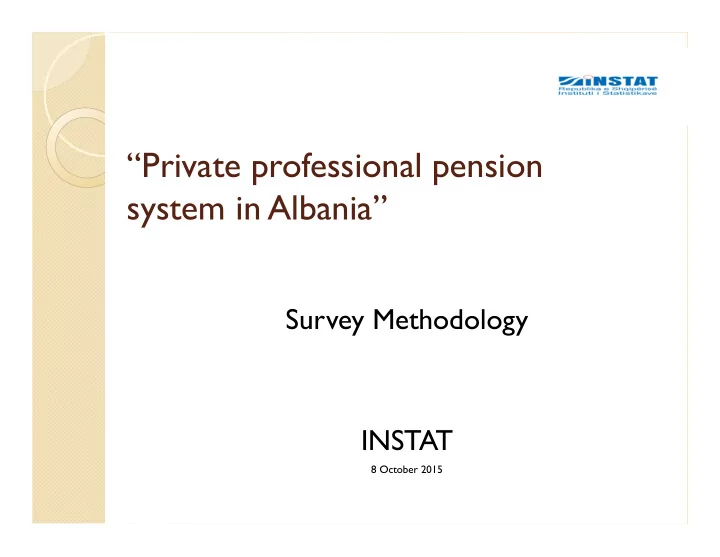

“Private professional pension system in Albania” Survey Methodology INSTAT 8 October 2015
The purpose Measuring the level of knowledge and recognition of employers and employees on private professional pension market in Albania, through statistical methods and methodologies.
Summary INSTAT, whose mission is “to provide transparent, neutral and timely statistics that help the user to judge on the developments of the transformation processes within the country”, in cooperation with the Financial Supervisory Authority and World Bank, conducted a survey on "Private Professional Pensions System in Albania“ INSTAT work consisted in developing the methodology of the survey, conducting the survey, statistical processing and analysis of results. The work phases: ◦ Preparatory phase; ◦ Field survey phase; ◦ Final phase;
First phase: Preparatory work Acquaintance with the purpose of the survey and the user needs for the required information; Establishing the working group; Developing a plan of activities and their duration; Determining the financial and human resources; Determining the unit that would be the focus of the survey Private enterprises which operate their activity within the territory of the Republic of Albania;
First phase(2) The type of Information Mainly qualitative information on the level of knowledge and recognition of private professional system of employers and employees in private companies; The information in the questionnaire was divided in three sections: General information about the company; Information on companies that currently do not have private professional pension plan; Information on companies that currently do have private professional pension plan; Concluding questions
First phase (3) Determining the methods and tools : ◦ Statistical methods: Face to face interviews with paper questionnaires, by phone (in some cases) and CAPI method (Computer Assisted Personal interviewing) using tablets, carried by interviewers authorized by INSTAT; ◦ Tools: Statistical Register of Enterprises; Nomenclature of Economic Activities, rev.2 ;
Phase Two: The used Methodology The population of the study: ◦ Enterprises with 20 employees and over; ◦ Economic activity according to the Nomenclature of Economic Activities, NACE Rev. 2 from section A to S, excluding section O; ◦ Non-agricultural enterprises with private ownership. Frame list with 2130 enterprises; In the sample were selected 651 enterprises ; The selection method is Stratified Sistematic Random Sampling (SSRS), ◦ Stratification variables were the economic activity of the enterprise and the enterprise size by number of employees. ◦ Allocation Method -Neyman according to employment.
Survey Field Work phase ◦ T esting of the questionnaire on paper and the tablet application; ◦ Finalizing the design of the questionnaire in the paper and tablet application: The questionnaire on paper completed; Tablet application using CSPro version 6.0; ◦ Selection of support staff for conducting the field survey: Supervisor: 1person Enumerators : 30 persons ◦ Geographical distribution: Throughout the country; ◦ Staff training and their acquaintance with the questionnaire and how to use the tablet: One day ◦ Conducting interviews in the field using combined methods: 15 work days Interview with paper questionnaire T elephone Interviewing CAPI interview using tablets
Advantages of CAPI method The collected data is stored in the device and is transmitted electronically on the site of the institution that makes the collection of data; Better quality of the survey results through the establishment of logical and routing conditions in the tablet questionnaire; The process of data entry in the computer system is eliminated . Electronic data transmission allows the data to be collected in central office in real time; Lower printing costs because there are printed only a certain number of backup questionnaires;
Third phase: final phase The collection of questionnaires : ◦ Paper questionnaires were delivered to INSTAT and data entry process took place; ◦ Transmission of data from the tablet to database was conducted using FTP connection between tablet and INSTAT server. Field work inspections ◦ T o monitor the field work, inspections were conducted by INSTAT staff on the way the questionnaires were completed, the use of the tablet, etc; Data cleaning ◦ After populating the database with collected data, data cleaning, verification and editing processes took place.
Third phase (2) Weighting process ◦ The data were weighted for the target population. ◦ The weighting procedure take in count: The probability of selection for enterprise Non-response adjustments are done for: refusals Out of scope and no contact
Allocation of sample by district No. of interviewed Refusals / Closed/ District No. of response enterprises No contact Passive 19 T otal 651 535 97 1 Berat 11 9 1 1 Diber 12 10 1 6 Durrës 75 66 3 0 Elbasan 16 15 1 Fier 39 38 0 1 0 Gjirokastër 8 7 1 0 Korçë 12 12 0 0 Kukës 2 2 0 0 Lezhë 9 9 0 0 Shkodër 29 29 0 10 Tiranë 422 323 89 0 Vlorë 16 15 1
Third phase (3) Weighting and data processing • The sampling frame contained 2130 enterprises. The final weights are representative for 2074 enterprises (2.63% of enterprises “over coverage”; • Enterprise codification • Calculation of accuracy for each of indicator estimation. • The sample guaranty an estimation of the total employment with coefficient of the variation 1.94 % representing the total of the population with 0.71 %.
Third phase (4) The study and analysis of data ◦ SPSS 20 was used for data analysis ; ◦ Key variables were grouped and tables related to them were built according to users requirements and needs for a more complete analysis of the study. Final report preparation.
Thank you for your attention!
Recommend
More recommend